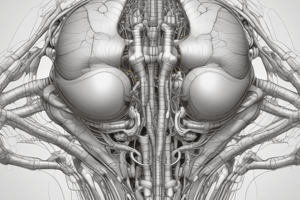Podcast
Questions and Answers
What is the biomechanical role of the cervical spine?
What is the biomechanical role of the cervical spine?
- Supporting the thoracic spine
- Facilitating the transfer of weight and bending moments of the head (correct)
- Regulating blood flow to the brain
- Controlling the movement of the arms
Which structure does the cervical spine primarily protect?
Which structure does the cervical spine primarily protect?
- Heart
- Spinal cord (correct)
- Lungs
- Stomach
What are the viscoelastic properties exhibited by intervertebral discs?
What are the viscoelastic properties exhibited by intervertebral discs?
- Flexibility, strength, and compression
- CREEP, relaxation, and Hysteresis (correct)
- Tension, expansion, and contraction
- Fluidity, rigidity, and viscosity
What is hysteresis in the context of ligamentous/IV disc properties?
What is hysteresis in the context of ligamentous/IV disc properties?
What is creep in the context of intervertebral discs?
What is creep in the context of intervertebral discs?
Flashcards are hidden until you start studying
Study Notes
Cervical Spine Biomechanics
- The cervical spine plays a crucial biomechanical role in supporting the head and facilitating movements such as flexion, extension, rotation, and lateral bending.
Protection of Structures
- The primary structure protected by the cervical spine is the spinal cord.
Intervertebral Disc Properties
- Intervertebral discs exhibit viscoelastic properties, which enable them to absorb and distribute mechanical stress.
Hysteresis and Ligamentous/IV Disc Properties
- Hysteresis refers to the phenomenon where the stress-strain response of ligamentous and intervertebral disc tissues varies depending on the loading and unloading cycles.
Creep in Intervertebral Discs
- Creep is a viscoelastic property of intervertebral discs, characterized by a gradual deformation in response to a constant load, resulting in permanent deformation over time.
Studying That Suits You
Use AI to generate personalized quizzes and flashcards to suit your learning preferences.




